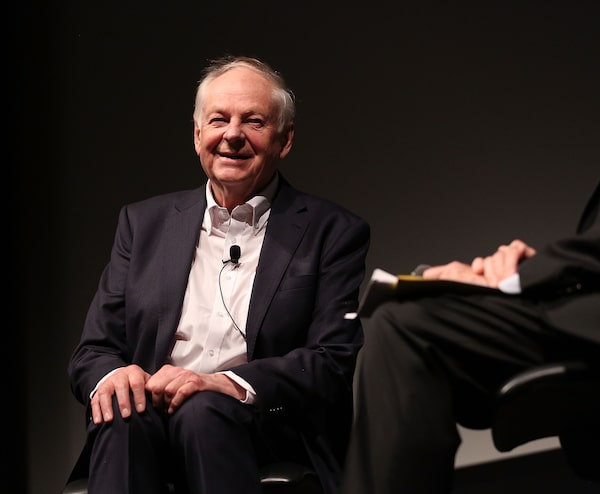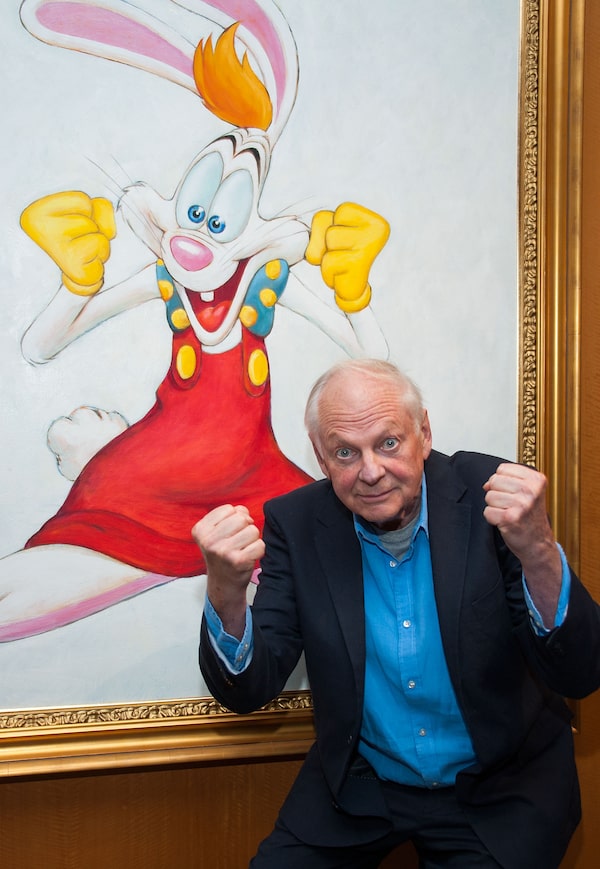
Who Framed Roger Rabbit led to Richard Williams receiving a special Oscar for animation direction and for creating new characters.Robin Marchant/Getty Images
Richard Williams, a groundbreaking animation director who won two Academy Awards for Who Framed Roger Rabbit, died Friday at his home in Bristol, England. He was 86.
His death was confirmed by his wife, Imogen Sutton.
Who Framed Roger Rabbit (1988), a film-noirish comedy, was the first Hollywood film to show live actors and animated characters interacting in ways that looked seamlessly real. Bob Hoskins played a detective on a Hollywood murder case. The suspect was Roger Rabbit (the voice of Charles Fleischer), a toon, as cartoon characters (living creatures) were known in the film’s fantasy universe. Roger’s voluptuous toon wife, Jessica (Kathleen Turner’s voice), spoke the film’s signature line: “I’m not bad. I’m just drawn that way.”
Chicago Sun-Times critic Roger Ebert called the film “enchanted entertainment from the first frame to the last.”
Mr. Williams received a special Oscar for animation direction and for creating new characters for the film, which featured many well-established cartoon characters, and shared a visual effects Oscar with Ken Ralston, Ed Jones and George Gibbs. The addition of the animated characters reportedly took 14 months of postproduction work.
He won his first Oscar (best animated short) in 1973 for a half-hour version of A Christmas Carol, featuring the voice of Alastair Sim (who had starred in the 1951 film) as Ebenezer Scrooge. Mr. Williams based his work on engravings from the original 1843 novella.
He and two co-producers shared a 1983 Emmy for Ziggy’s Gift, a television special in which Ziggy, the childlike comic strip character, took a job as a sidewalk Santa.
But his greatest project remained unfinished. Work on The Thief and the Cobbler, an Arabian Nights-inspired film, began in the 1960s. In the 1990s he lost control to financiers, and it was released in several versions under several titles.
When The New York Times reviewed a new print in 2016, Glenn Kenny compared it to Orson Welles’s The Magnificent Ambersons – “a staggering masterpiece that can never be seen in its ideal form.”
Mr. Williams was the author of The Animator’s Survival Kit (2001). The book, “a collection of methods, principles and formulas,” included a whole chapter on “runs, jumps and skips.” It became an essential industry reference, in print and as a 16-DVD box set. Film historian Kevin Brownlow called it “utterly riveting, even to a layman.”
Mr. Williams’s career advice was sometimes less than idealistic. “Persist,” he once told a screening audience. “Keep going. Don’t get stopped. Because they’re going to stop you if they can.”

In the 1960s, he worked on television commercials, film title sequences and his pet projects.Valerie Macon/The Canadian Press
Richard Edmund Williams was born on March 19, 1933, in Toronto, where he was brought up by his mother, Kathleen (Ball) Williams, an illustrator, and her second husband, Kenneth Williams, a commercial artist.
He liked to say that his mother was his inspiration, but she insisted it was Walt Disney. During a Museum of Modern Art interview in 2016, Williams quoted her as telling him, “You saw Snow White when you were 5, and you were never the same.”
At 15, he ran away from home, traveling to California in hopes of meeting Disney, but his mother insisted he return. He took courses at the Ontario College of Art, and at 16 was earning a living as an illustrator. Then he had a change of heart.
Deciding that fine art was his real calling, Mr. Williams spent two years painting in Ibiza, Spain. He also played in a jazz band there. (That passion endured; as a cornetist, he went on to lead several bands.) When he returned to animation, he worked for an animation studio in London and then opened his own.
In his first film, a self-financed short called The Little Island, three goofy little men on a desert island each believe in a single virtue: truth, beauty, good. It won a 1959 BAFTA (British Academy of Film and Television Arts) award.
The Charge of the Light Brigade (1968), a live-action drama starring John Gielgud, brought Williams wide attention. Writing in The Times, Vincent Canby described his contributions as “marvelous animated line drawings, done in the style of patriotic mid-19th-century cartoons.”
In the 1960s he alternated between commercial jobs – actual television commercials and film title sequences (A Funny Thing Happened on the Way to the Forum; the Pink Panther sequels) – and his pet projects. He earned high praise for A Lecture on Man (1962), a satirical four-minute analysis of homo sapiens.
Mr. Williams continued working into his 80s, putting in at least seven hours a day, he told the Museum of Modern Art audience. He liked to enter his second-floor office by the fire escape, he said, just to avoid people.
“Nobody’s going to call me” – well, maybe his wife, he acknowledged – “Nobody’s going to walk in. I don’t have to say hello to anybody. You know, I’m free.”
In addition to his wife, who is a producer and director, he leaves three sons, Alexander, Timothy and Leif (who uses the surname Sutton-Williams); three daughters, Claire, Holly and Natasha; a brother, Anthony; and seven grandchildren. Four of his children are from previous marriages.
His last Oscar nomination was for Prologue (2015), which depicted a Peloponnesian War battle, complete with nudity and gore. In an interview with Cartoon Brew, he called it “the only thing so far in my career that I’ve ever really been pleased with.”
It was to be part of a feature film adaptation of Lysistrata. In 2013, he was hopeful as he told The Guardian, “All I need is some time and five or six assistants who can draw like hell.”